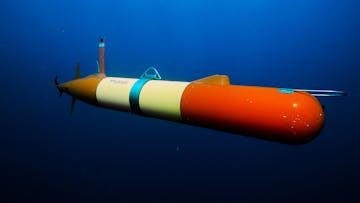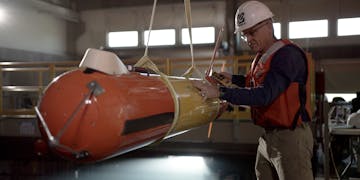The ocean covers more than 70 percent of the planet’s surface and its expansive depths represent the largest living space on Earth. In the face of threats like climate change, monitoring ocean health is increasingly urgent, but logistically challenging. To understand the massive marine environment, scientists need research tools that can travel far and wide. Autonomous robots are essential to the future of marine science, engineering, and exploration. Nimble research tools can scale our observations of the ocean and its inhabitants at this critical time.
The long-range autonomous vehicle (LRAUV) is an innovative robot developed by MBARI engineers to meet the growing demand for technology that can safely and efficiently explore, map, and monitor the ocean. After a decade of extensive testing at sea by the LRAUV Team, this technology is now available to a global market for the first time. Thanks to a commercial licensing agreement with Saab, Inc., the MBARI LRAUV will be available commercially as the Saab Tethys. This partnership will make this versatile platform available to our peers in the ocean science community.

The MBARI LRAUV is an innovative, field-ready autonomous robot that can be launched from a ship or from shore. An ultra-low power transit mode enables shore-based operations with a range of more than 1,000 kilometers (620 miles). Docking stations facilitate data transfer and recharge the vehicle’s battery.
The MBARI team developed this technology as a scalable solution to ocean-based data collection. To aid in the smooth export of the LRAUV to new users, MBARI software engineers have developed an independent computer system for users to safely control the vehicle along with an open-source simulator to confirm all new control software performs as expected.
MBARI’s fleet of 10 LRAUVs has more than 42,200 hours of sea time. The LRAUV is more than a vehicle—it is a tech ecosystem capable of a variety of science missions. The vehicle supports industry-standard instrumentation for core science as well as custom-designed payloads that leverage MBARI’s expertise in marine technology and engineering innovation. The LRAUV can conduct environmental DNA (eDNA) sampling, use three-dimensional cameras to visualize plankton and marine life, map the seafloor with scientific echosounders, and more. This robust platform has demonstrated some remarkable mission capabilities, from sampling the genetic fingerprints of marine life to monitoring harmful algal blooms in the Great Lakes to detecting and mapping oil spills. Multiple vehicles can work with each other and, thanks to MBARI software engineering, adaptively respond to their environment. A fleet of LRAUVs exponentially expands the depth and detail of scientific observations at sea.
“MBARI is one of the few places where a team of engineers and scientists can work together, for more than 10 years, to develop a completely new ocean robot from the ground up.”
—Senior Mechanical Engineer Brett Hobson

Silicon Valley innovator David Packard believed that addressing the unique challenges of ocean exploration required a new type of research institute—one independent in spirit and collaborative by design. He founded MBARI on the core principle of science, engineering, and marine operations working together in equal partnership to develop innovative marine technology. Today, MBARI is known for our willingness to think big, be bold, and invest in long-term outcomes. The LRAUV tech ecosystem embodies Packard’s legacy by integrating diverse and innovative sensors to enable autonomous and extended monitoring and exploration of the ocean.
About two meters (6.6 feet) long, 30 centimeters (12 inches) in diameter, and weighing 110 kilograms (242.5 pounds), the LRAUV is easy for small teams to operate anywhere in the world. The LRAUV can dive to depths as great as 1,500 meters (4,900 feet). It is capable of supporting larger, more powerful payloads and can operate in higher currents than buoyancy-driven oceanographic gliders. The LRAUV can be outfitted with a variety of payloads, including microbial sampling, bioluminescence sensing, active bio-acoustic imaging, water sampling, plankton imaging, and multibeam mapping.

The LRAUV can be outfitted with a variety of payloads, including DNA samplers, cameras, scientific echosounders, and more. Image: © 2021 MBARI/Monterey Bay Aquarium
The LRAUV’s unique low-power transit mode and over-the-horizon, internet-based remote control allow users to launch the vehicles from shore and conduct sophisticated missions at remote locations.

From the start, MBARI engineers designed the LRAUV to function without a host ship. Early deployments required small boats to launch the vehicle. The first fully ship-free operations began in 2017 during a collaboration with the National Oceanic and Atmospheric Administration (NOAA) using the LRAUV to monitor blooms of toxic algae. Since then, MBARI has been routinely launching LRAUVs from beaches and piers along the coast of California and the Great Lakes. In December 2022, MBARI engineers ran the first deployment of the LRAUV from the beach outside our research facilities in Moss Landing, California.
Launching and recovering the LRAUV from shore instead of from a ship frees up research vessels to host the complicated expeditions that they are best suited for. Shipless operations are more nimble and also better for the environment. Technologies that can be deployed from shore have a smaller carbon footprint. When launched from land, the battery-powered LRAUV is an emissions-free tool. Our new docking station recharges vehicles with energy harvested from the sun. MBARI engineers are working towards carbon-free LRAUV operations in the near future.
Critically, shipless deployments help expand access to the ocean. Not all research institutions have access to a ship. Even if they do, operating those platforms is expensive. The ocean is at a critical crossroads and it is more urgent than ever to mobilize a wide variety of science and engineering efforts for ocean exploration. Reducing barriers to accessing the ocean is vital.

The MBARI LRAUV is a versatile science platform that can be deployed and recovered from a ship or from shore. Image: Todd Walsh © 2022 MBARI
Under its Autonomous and Undersea Systems Division, Saab, Inc. will transition the MBARI LRAUV to commercial production. They plan to offer this product for global sales for the oceanographic research, commercial, and military markets.
Understanding the ocean’s complex physical and biological processes requires robust observing systems. MBARI engineers envision a future where robotic platforms can monitor ocean health 24 hours a day, 365 days a year. Licensing the LRAUV technology to Saab, Inc. for commercial production brings us closer to this vision for an autonomous future for ocean exploration.
